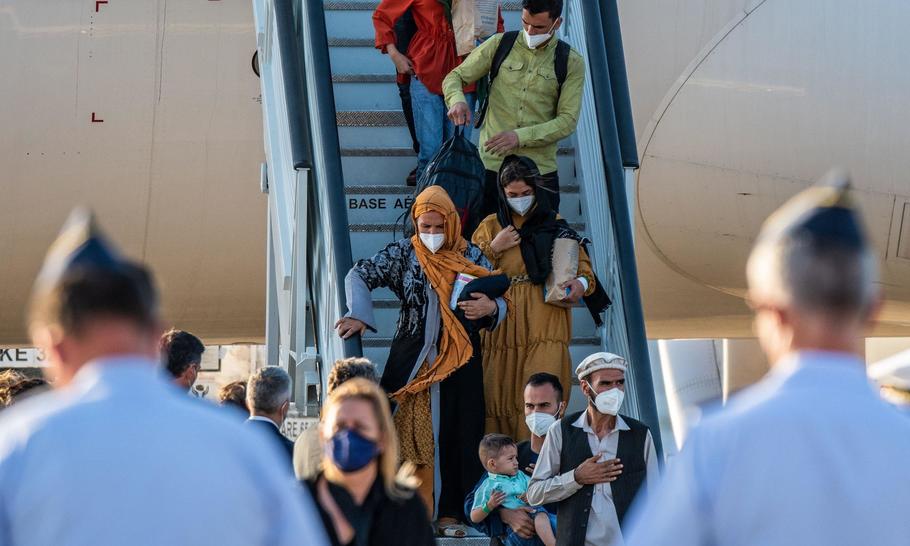The fall of Afghanistan was foreshadowed here. What will come next?

Afghan people arrive in Madrid 27 August 2021 (Marcos del Mazo/Alamy Live News)
Our Twenty Years’ War in Afghanistan is over. With the evacuation of the last American forces, Nato’s mission has finally ended. But is it accomplished?
The answer depends on what happens now and in the future. The United Nations Security Council, which authorised the intervention in 2001, has passed a resolution calling on the new Taliban regime to prevent the land they now control becoming once again a haven for Islamist terrorists. The presence of al-Qaeda, perpetrators of the 9/11 attacks, in Afghanistan was the Allies’ original casus belli. The suicide bombing by the Islamic State of Khorasan, or Isis-K, at Kabul airport last week, which killed 13 US troops , two British civilians and some 170 Afghan s, indicated that terrorists are still operating in the country. Taliban leaders have sworn to destroy Isis-K and to deny their territory to other foreign terrorist organisations. Few in the West believe we can rely on their promises about this or anything else. Yet for the foreseeable future we now have no other choice but to trust the Taliban.
Nobody can say that we were not warned. Two-and-a-half years ago, readers of TheArticle were the first to learn of the deal between the US and the Taliban that was already being agreed in secret talks. The story was broken on March 5, 2019 by our then foreign editor Lynne O’Donnell and the Pakistani journalist Mirwais Khan, in a report datelined London and Quetta and headed “World Exclusive: In secret talks with the Taliban, Trump dumps the Afghan government”. Their story, based on senior Taliban sources in Quetta, revealed for the first time the outlines of the agreement they had been offered by the Trump Administration’s chief negotiator, Zalmay Khalilzad, while entirely excluding the Afghan government of President Ghani. The core of the deal was that the US demanded two years to withdraw its forces, civilians and Afghan “affiliates”. At the time, the Taliban was offering just six months, but they told our correspondent: “Now let’s see what timeframe we decide on, but up until now it has not been confirmed.”
After another few months of talks, the Americans got their two years. But in March 2019 the Taliban had already been given their key concession: the US would allow them to play “a key role in governing the country”, regardless of the wishes of the elected Afghan government. The Americans were mainly focused on a ceasefire and a timetable for their withdrawal. In return, the Taliban promised that “Afghan territory should not be used by any terrorist group for attacks”. The Taliban confirmed that “both sides have accepted both these points”. They were still negotiating which positions they should be offered in a future government. But they consistently refused, then and later, to recognise the post-2001 Afghan constitution, which guarantees democracy, civil and human rights — or the elected Afghan government.
The report by O’Donnell and Khan also quoted an unnamed Afghan security official. He was clearly angered by the way in which President Ashraf Ghani and his colleagues had been marginalised and delegitimised by the President Trump and his negotiators. They knew that there was no chance of the Taliban serving alongside their officials in a joint administration. “I The Taliban is not a political movement, no matter what platform they are given, they are a violent movement,” he said. “They only have violence, you cannot politicise them, if you think they will abandon violence you are mistaken.”
He added: “What is important for us is not to be fooled by these peace agreements that Zal [Zalmay Khalilzad] has come up with. Nobody should trust nobody, and of course not Zal.”
All the events of the last few fateful weeks were already foreshadowed in Lynne O’Donnell’s exclusive for TheArticle. She grasped — rightly— that the Trump Administration had “dumped” the Afghan government. The Biden Administration stuck to the agreement, which meant essentially the same policy. Any assurances given to the Afghans proved worthless, once the withdrawal had begun. Their armed forces quickly collapsed. Ghani had read the runes and fled as soon as the Taliban reached Kabul.
In the event, the Taliban have kept their promise to allow a more or less peaceful evacuation. The part of the agreement that matters to the US now concerns terrorism. But the European Nato partners are no less concerned about refugees. According to a senior Russian parliamentarian, some four million Afghans are now on the move, pouring into neighbouring countries in Central Asia. Vladimir Dzhabarov, deputy head of the foreign affairs committee in the upper house of the Duma, claims that this exodus is already “the largest humanitarian catastrophe, bigger than anything we have seen this century. Where will these people go?”
The answer, for those who can make it, is Europe. Many have family connections here and for economic, social and legal reasons, Britain and the EU remain the destinations of choice for most refugees. The 20,000 Afghans whom Boris Johnson has promised a home in Britain will almost certainly be the first of many. The 15,000 mainly Afghan civilians airlifted from Kabul by the RAF, plus others who had already arrived under various schemes, mean that this quota has probably already been filled. Many more will seek asylum here: we must hope that most will use the legal process, but it won’t be possible to prevent others from entering illegally, very likely exploited by people traffickers. The new Nationality and Borders Bill, which makes illegal entry a criminal offence and people trafficking punishable by life imprisonment, has still not become law. it is already clear that enforcement will be a daunting task. But many thousands of Afghan refugees will qualify for asylum. Even the provisions in the Bill to return asylum seekers to “safe countries” (which includes the whole EU) depend on these countries being willing to accept them. At present, British public opinion is sympathetic to the Afghans, especially those who have worked with our forces for past two decades. But that tolerance may not last.
Most wars end messily. Both world wars resulted in humanitarian crises on a vast scale, with displaced people in their millions traversing Europe and seeking new homes beyond. The same has been true of many other conflicts since 1945. We cannot expect this one to be very different. The likelihood is that the consequences of Afghanistan’s Twenty Years’ War will be felt for many more years to come. The least we can expect from our leaders is that they should go into this new phase with their eyes open, sharing with the public what they know and don’t know. We do not know, for example, what the Allied presence in Afghanistan may have been preventing for many years and what may now be unleashed upon us. The war against the Taliban has been a long ordeal. The peace may be an even longer one.
A Message from TheArticle
We are the only publication that’s committed to covering every angle. We have an important contribution to make, one that’s needed now more than ever, and we need your help to continue publishing throughout the pandemic. So please, make a donation.





